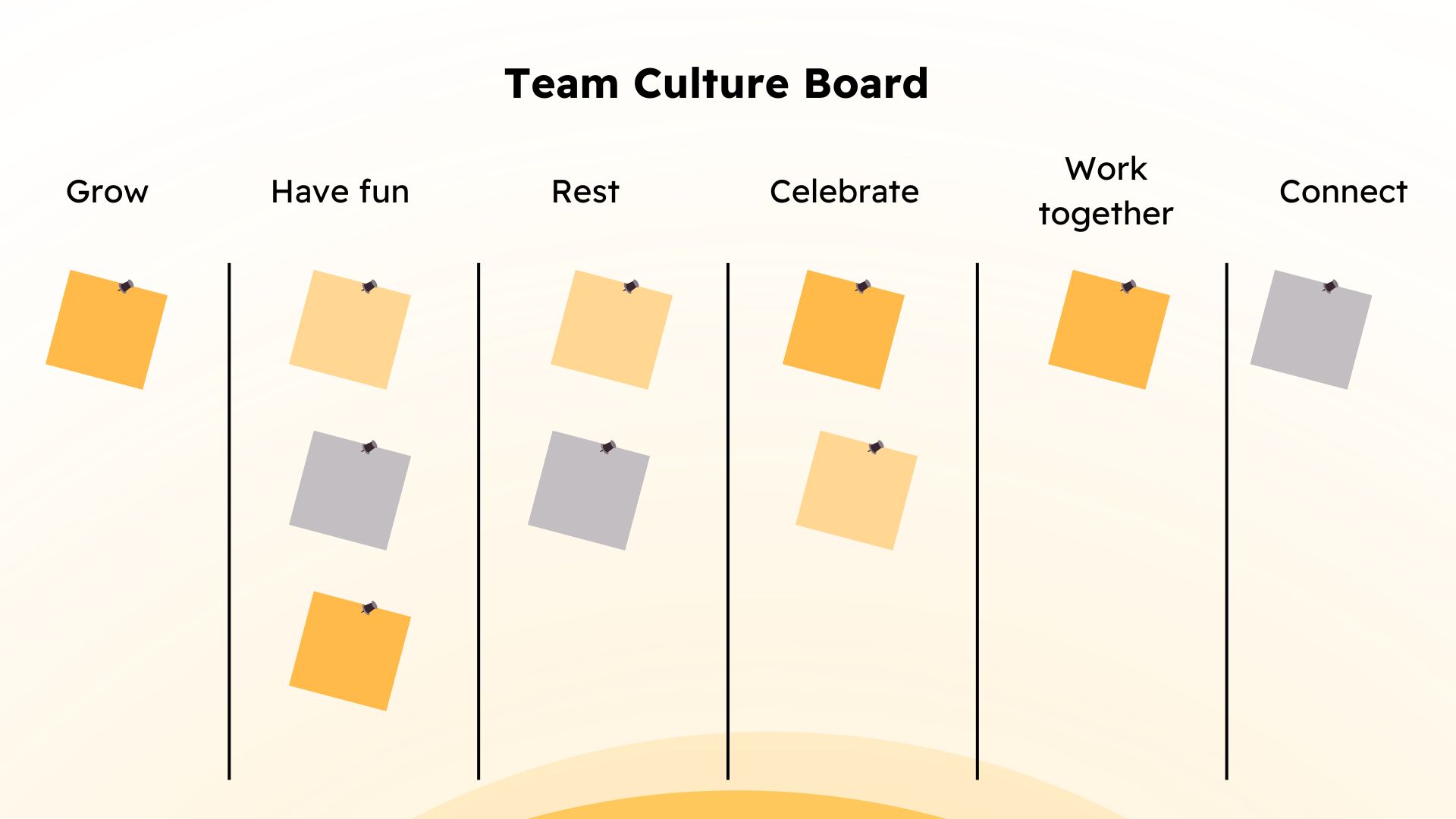Create your team culture board
Create your team culture board
Create your team culture board
5 minutes

In today’s hybrid and rapidly evolving work environment, the cultivation and maintenance of a positive team culture has never been more crucial. The interactions and conversations that unfold from day to day within a team are part of the foundation where culture is built and sustained. Just as a well-trodden path through grass becomes defined through constant use, so does the way we interact, engage and communicate with our teams. Like a grass-trodden path, the moment these interactions cease or reduce, the path begins to overgrow, and the once clear track becomes obscured. Recognising this, the most effective leaders actively engage in maintaining team rituals and creating opportunities for connection that are both fun and meaningful.
While many teams excel at devising strategies for achieving business outcomes, they often overlook the equally important task of planning for how you develop team relationships, connections and a supportive culture that underpins those results. Whether teams operate remotely, in a hybrid model, or fully onsite, establishing a framework for success involves not just a focus on the what and the how of work, but also on the who and the why of the team dynamic.
Building a team “Culture Board” can be a great way of articulating and sharing the agreed and understood team dynamic, or way of working together. Follow these steps to lead a team culture conversation:
Set aside one and a half to two hours for a focused conversation on team culture, labelling the session as a “Cultural Brainstorm” or “Working Together.” Providing context for this meeting is essential to ensure that participants come prepared to engage meaningfully. Sharing an article, an agenda and some reflection questions set the stage for an effective conversation. Provide your team with these questions:
Personal reflection:
- What skills or knowledge do you want to develop or improve?
- How can our team assist you in achieving your goals?
Team reflection questions:
What can we do as a team to…
- Learn and grow: For example, attend webinars, cross-skilling, watch Ted talks, have a book club, share articles
- Have fun: For example, have virtual coffee meetings or happy hours, have trivia questions at the beginning of meetings
- Rest & Rejuvenate: For example, no meeting before 10:00 am on Mondays, walking virtual meetings, no emails after 6 pm, focus days, exercise breaks or stretch breaks in meetings.
- Celebrate and Appreciate: For example, start meetings by giving shout-outs to each other
- Connect & Reflect: For example, one-to-one check-ins with each other or post-project debriefs
Leader preparation
Before the session, select a virtual tool to allow for easy brainstorming. Great tools to use include:
- Google doc
- Online Microsoft Word doc
- Miro board
- Idea Flip
These steps ensure that each team member arrives at the session with thoughtful contributions, ready to share and build on the ideas of others, and you have an environment set up ready to capture their thoughts and contributions.
Once everyone’s logged in and ready to go, kick things off by reminding the team why you’re here.
“Today’s all about plotting how we can create a winning team culture that helps us grow professionally and brings out the best in us.
Let’s keep in mind that we’re here to brainstorm, which means all ideas are good ideas. We’ve all got different needs and wishes. Instead of hitting the brakes with a ‘No way’ or ‘Not my thing,’ let’s switch gears and think ‘How can we make this work?’ or ‘What could we add to bring this idea to life”
Reshare the reflection questions and ask for a volunteer to share their goals. Give each person in the team 2 minutes to share.
Record these goals and follow up with your team members in your next 1:1 with how you can support them.
With ideas generated, go through each section one at a time and have people share their favourite ideas for each. Capture all of your team’s ideas in a shared space or document that you have pre-prepared.
With ideas generated, have your group organise ideas into the following categories:
- General processes and practices
- Meeting Ideas
- Behaviours and values
- Team Rituals
- Special Occasions
- Anything else

After the team has their ideas sorted into these groups, have people share the ones they are most excited about and see who wants to take ownership of each. Set specific dates to get your initiatives up and running.
This process not only identifies what the team is excited about but also assigns ownership of different initiatives, ensuring that plans translate into action.
Conclude the session with reflection by asking each team member to express their feelings about the activity. Acknowledge the collective commitment to fostering a supportive team culture and thank you team for their involvement.

Hellomonday